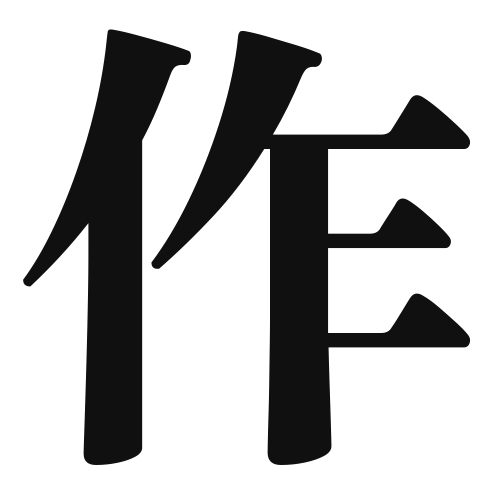1. Overview of Meaning
The kanji 作 (saku) generally means “to make” or “to create.” It is often used in contexts related to production, crafting, or artistic creation.
2. Formation and Radical
Formation of the Kanji: The kanji 作 is a compound character (会意文字) that combines elements to convey its meaning. It consists of the radical 亻 (the “person” radical) on the left, indicating human action, and the character 作 on the right, which relates to “to make” or “to do.”
Radical: The radical of 作 is 亻, which signifies a person or human activity.
3. Examples of Usage
Common Words and Phrases: Some frequently used words that include 作 are:
- 作品 (sakuhin) – “work of art” or “piece of work”
- 作業 (sagyō) – “work” or “task”
- 作成 (sakusei) – “creation” or “preparation”
Example Sentences in Daily Conversation:
- この絵は彼が作ったものです。
(Kono e wa kare ga tsukutta mono desu.) – “This painting is something he made.” - 新しいプロジェクトを作成しています。
(Atarashii purojekuto o sakusei shiteimasu.) – “I am creating a new project.”
4. Synonyms and Antonyms
Similar Kanji: A kanji with a similar meaning is 製 (sei), which means “to manufacture” or “to produce,” but it is more focused on industrial production rather than artistic creation.
Antonyms: A kanji with an opposite meaning is 壊 (kai), which means “to break” or “to destroy.”
5. Cultural and Historical Background
Relation to Japanese Culture: The concept of 作 is deeply embedded in Japanese culture, particularly in arts and crafts. Traditional practices such as pottery, calligraphy, and tea ceremony emphasize the importance of creation.
Proverbs and Idioms: One common saying is 作るは一時、壊すは一生 (tsukuru wa ichiji, kowasu wa isshō), which translates to “Creating takes a moment, but destroying lasts a lifetime,” highlighting the value of creation versus destruction.
